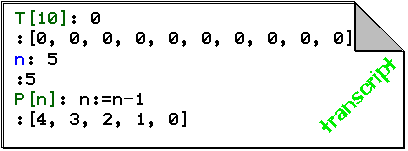Pico allows values to be combined into tables. Tables -very similar to vectors from mathematics- are defined by using an indexed invocation:
|
name[expression]: expression |
Tables are named and this name is used
to define a variable in the current dictionary. The square brackets
are a hint needed by Pico to indicate that a table is considered;
they delimit a size. Any expression with a non-negative number
value can be used as a valid table size. The freshly defined variable
will be bound to a table, that is a sequence of value slots. The
number of slots is defined by the indicated size (and might be zero).
Each slot can hold an arbitrary value, which is initially set to a
newly computed value of the expression to the right of the colon.
Therefore, the following expression:
introduces a variable named
T
bound to a table containing ten slots each containing the value
0.
The following transcript illustrates a more sophisticated use of
tables:

Note that the value of a table
definition is the table itself; its slots are displayed by the
print
component as a list delimited by square brackets and separated by
commaÌs. Also note that the slot values of
P
are computed from left to right using the expression
n:=n-1,
starting with the value 5
for n.